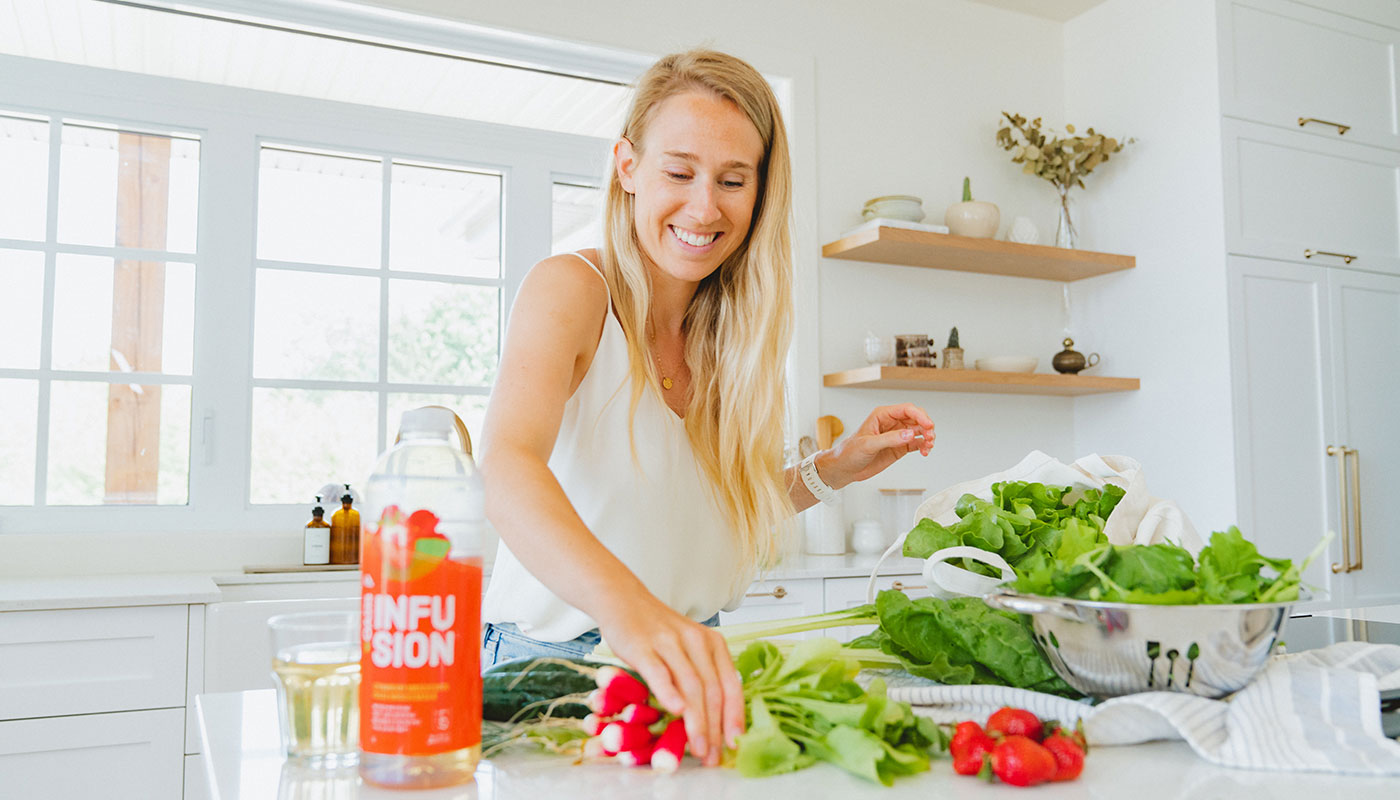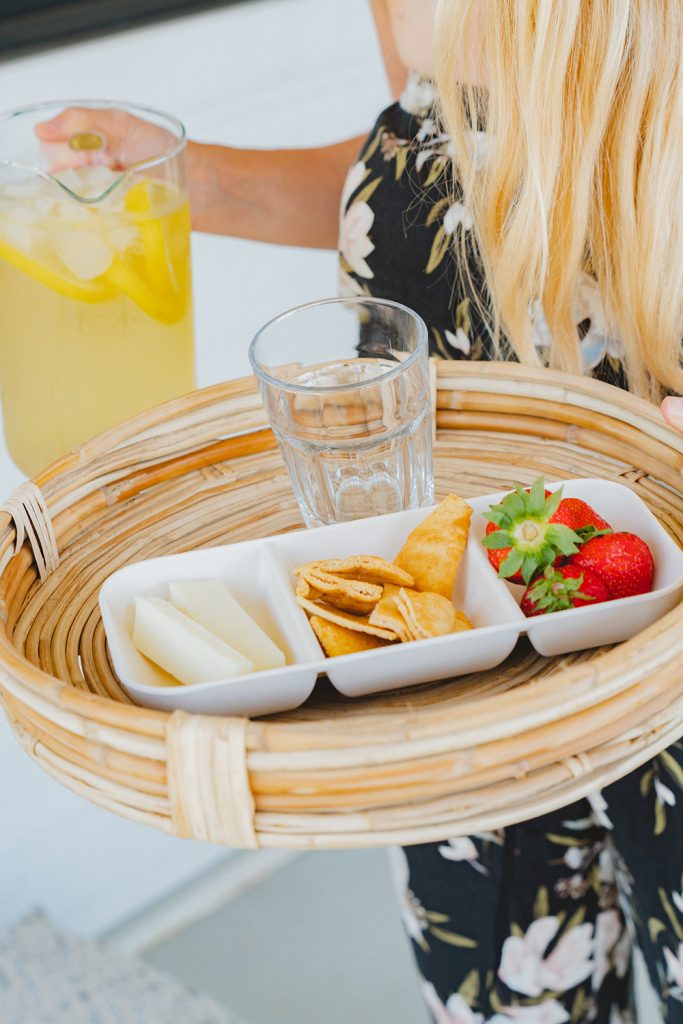
While neither of the women claimed to be experts on intuitive eating, both share a similar understanding of eating based on the idea that we should listen to our body before our head when it’s time to eat. As former gymnasts, they now both describe themselves as unapologetic foodies. Here’s a portrait of their encounter led by Virginie.

What does intuitive eating mean to you Julie?
The human body is an incredible machine that should be listened to more often when it comes to eating. Yet, it’s often put aside to rely on many other external factors such as diet, meal times, and the nutritional value of food. Instead of listening to our bodies, we intellectualize the act of eating by asking ourselves thousands of questions. The only entity that can tell us what to eat and how much is our body. What I love about intuitive eating is that it makes us realize all the mistakes that can be made when it comes to food.
I’m sure you’ll agree with me when I say intuitive eating is actually eating mindfully.
Absolutely! Often times, instead of eating because it tastes good, we try to find reasons to do so: we eat fish because it’s high in Omega-3 or vegetables since they contain a lot of beneficial antioxidants preventing disease. It’s the same with emotions. When we feel sad, we eat. Even with celebrations or fights – we eat, it’s all the same.
Intuitive eating can be a big challenge for anyone who is disconnected from their body, who has been on a lot of diets, and who has always eaten restrictively. Finding harmony with food and moving away from restriction or obligation is a long process.
The examples you’re giving here are really relevant. We eat so unconsciously that we don’t even realize that we are doing it with all these restrictions.
You know what I like to say? The more pleasure there is per bite or sip, the fewer bites and sips. Pleasure is also taking the time to smell and chew food to appreciate every flavour. When we do this – amongst other things – it allows us to eat slower, in addition to helping us feel full sooner.

Intuitive eating is not just what we put on our plates or what we eat: it’s really a way of life and even with the help of specialists, you have to get started to figure out how to give it a try.
Right! It is much broader than a guide or dietary models. The more we eat mindfully, the more we’re able to respect our body. But again, we have to disregard what’s around us. Watching TV, or working on the corner of a table – those are not ways to fully connect with our meals.
We all have different ways of approaching intuitive eating, but what are the basics?
First and foremost, it’s important to reflect on your relationship with food. A person who doesn’t have a healthy relationship with it, such as someone suffering from dietary restrictions or emotional eating, should understand the cause of this relationship before trying intuitive eating. In these cases, the help of a therapist or nutritionist is recommended and sometimes essential.
Intuitive eating is based on ten principles. In my opinion, the basis of it lies mainly in two principles, the first of which is to reject the diet mentality. We need more self-trust. We have all the necessary tools to be able to optimize our eating habits in terms of quality and quantity. In doing this, you also have to do the work to respect the second principle, which is to stop thinking that there is good and bad food.
I find it super important to seek the help of a specialist and this is often what I recommend to the people around me, because it’s not easy to let go of something we’ve been told all our lives about certain foods.
Yeah, there’s a double challenge here: on one hand, we must honour our hunger, but on the other hand, we must be aware of our satiety. This is a big challenge for a lot of people because we don’t take much time to eat and most of us were raised with the “Finish your plate or you won’t have dessert!” mentality. We were taught that there were three meals a day and that we had to eat at specific times. Still, the logic is to feed your body when you’re hungry, no matter what time of day it is. And why keep feeding yourself if you no longer need energy? That’s common sense, but damn, it’s not always easy to do!

Do you have any tips for families who find it difficult to honour their hunger and food preferences when there are five around the table?
First of all, honouring hunger and satiety – that’s something anyone can do, no matter what we have on our plates. For some people, this will take more practice, but we have all the tools we need to do it.
Obviously, you can’t always eat what you want, but the idea of thinking about weekly meals as a team alleviates the task of the person who prepares the meals, and above all, allows everyone to eat food they really like. It’s as easy as opening flyers and asking your children what vegetables or protein sources they want to eat during the week! By involving our children, they feel that they’re being listened to and therefore food aversion or refusal becomes rare. Two birds, one stone!
Intuitive eating doesn’t have to be “perfect” by following a 24/7 schedule. The idea is to learn to reconnect with your body, to listen to it, and honour your desires and hunger. From time to time, you will feel like binge eating and that’s okay. It’s like everything else, you have to find balance and above all, not bang your head against the wall when you realize you’re imperfect. Eating is fun, let’s make sure it stays that way!
Intuitive eating gives wings to a food philosophy in which Virginie and Julie particularly believe in: one which states that pleasure should be at the heart of our diet. But if this is true when it’s time to eat, it is also true when it’s time to move, to take care of our skin, our mind, and even our home. Learn more about the different ways you can contribute to your overall wellness by reading our articles based on the four pillars of well-being.
